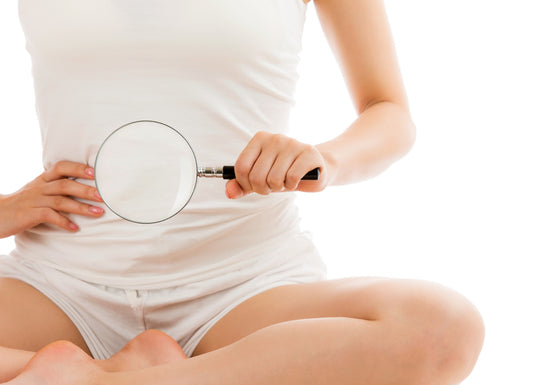According to the American Academy of Family Physicians, between 10-20% of women experience dyspareunia (pain or difficulty during sex) at some point in their life. Unfortunately, because many women don’t report their symptoms and don’t seek help, many experts agree that the number could be even higher.
When it comes to dyspareunia, sexual pain disorders, and pelvic pain in general, there can be a range of things at play including both physical and emotional health. Not to mention the interesting and totally complex interplay of pain and the nervous system.
There’s no one-size-fits-all approach to treating this type of pain, but there is one easy thing that most women experiencing dyspareunia can add to their tool kit that can make a big difference in smoothing things over.
Yup, we’re talking about lube to address vaginal dryness. It’s not just for porn stars, it’s also for normal, everyday women (and men) just like you, who want sex to be easy, fun, pleasurable and playful. But seriously, who doesn’t want that?
Why use lubricant?
If you haven’t been using lubricant in your repertoire of intimacy yet, why not?!
One of the biggest causes of pain or discomfort during sex is not enough lubrication. Vaginal dryness causes friction, and friction isn’t fun for anyone.
Let’s get back to basics. Your body produces its own natural lubrication when you’re turned on. But how wet you get isn’t just about desire.
Age, medication, birth control, breastfeeding, hormonal fluctuations based on your menstrual cycle, stress, menopause and other conditions such as diabetes and inflammatory bowel disease can all have an impact on the amount of natural lubrication your body produces at any point in time.
Extended foreplay can help, and is loads of fun, but if you feel anxious or worried about how wet you are it can be a real buzz kill. It’s kind of like trying to get an erection on command, our bodies just don’t work that way.
While the body’s natural lubricants and natural vaginal lubrication prevent vaginal dryness and increase women’s sexual pleasure, there’s nothing wrong with artificial lubricant to help with vaginal dryness. Here’s where a good artificial lubricant can help with vaginal dryness. It will reduce friction and take away any worry you have about how wet you are or how uncomfortable sex might be. It may even enhance sensations or create new ones for both you and your partner (sexy!).
All lubricants are not created equal
Now that you’re sold on adding lube to your box of tricks (pun fully intended), before you go out and grab the first tube you can get your hands on it’s important to understand what to look for in a lube.
Why? Well, it might surprise you to find out that a lot goes into making a really good lubricant.
We did so much reading and translating medical jargon (we’re talking days upon days of talking nothing but lube) to make sure the information we give you is useful and trust-worthy.
This information is based on recommendations from the World Health Organization and up-to-date research. But we need to note that most lubricant (and personal care product) studies are conducted either on animals or the skin cells on a person’s arm. And it goes without saying that the skin on your arm is a far cry from the tissue of your vagina and rectum.
No nasties

Many popular, over-the-counter lubricants contain ingredients that mess with your vagina’s happy environment. Changing the pH levels of your vagina and killing off good bacteria by introducing a less than awesome lube can put you at risk of developing a bacterial infection. And they’re as nasty as they sound.
Ingredients like parabens, bulking agents, microbicides and preservatives, added flavors and warming gels, glycerin, glycols, grapefruit extract, petrochemicals and mineral oils, and chlorhexidine should all be avoided, why?
Parabens are preservatives and are similar to the female sex hormone, estrogen. It has been suggested that parabens may disrupt the endocrine system, and they have been detected in breast tumors.
Bulking agents like synthetic glycerin, glycerol monolaurate, polyethylene glycol, propylene glycol are used in most over the counter lubricants. They generally create a neutral pH environment killing off the good bacteria in your vagina and increase the transmission of genital herpes infections.
Microbicides and preservatives can cause damage and inflammation to genital mucosa, alterations in the vaginal microbiome, and increased susceptibility to sexually transmitted infections. Nonoxynol-9,a compound added to lubes and some latex condoms for contraception because it kills sperm, damages the vaginal and rectal lining and increases risk for herpes and HIV. And chlorhexidine is a preservative associated with a 100-fold increased susceptibility to chlamydia.
Added flavors and warming gels are generally made with petrochemicals, need we say more!?
Glycerine, a sugar alcohol, can lead to bacterial growth and unpleasant side effects like bacterial vaginosis, yeast infections and UTIs.
Glycols, molecules responsible for maintaining moisture, too much glycol can cause vulnerability to herpes simplex virus 2, bacterial vaginosis, and yeast infections.
Grapefruit extract can be irritating and has actually been banned in Switzerland in personal care products. It all depends on how the grapefruit extract is processed and whether other chemicals are added in the extraction process (like, methylparaben and triclosan). If there’s grapefruit extract in your lube, be sure it’s a brand you know and trust.
Petrochemicals and mineral oils (e.g. propylene glycol, polyethylene glycol, and petroleum) are chemicals derived from fossil fuels and include gasoline, coal, tar, and petroleum. Petrolatum is an inexpensive and effective sealant that traps moisture, but it may contain trace impurities of polycyclic aromatic hydrocarbon (PAH), a possible carcinogen.
Chlorhexidine gluconate is a preservative associated with a 100-fold increased susceptibility to chlamydia.
Cyclopentasiloxane (D5) and cyclotetrasiloxane (D4) are used to protect the skin and to retain moisture and are commonly found in silicone-based lubricants. Both D4 and D5 have been added to the 2018 European chemicals agency “New substances of Very High Concern” list (more info here). Cyclotetrasiloxane (D4) is toxic to the human reproductive system and it accumulates in the environment with unpredictable long-term effects. It’s difficult to differentiate between D4 and D5, but basically you want to look for very pure cyclopentasiloxane (D5) (purity rating of 99%) that does not contain any cyclotetrasiloxane (D4). This is where buying from a brand you trust, that uses only the highest purity raw ingredients, is really important.
Polyquaternary compounds research conducted on lubricants that contain polyquaternary compounds have found a potential link to increased likelihood of contracting HIV. According to the World Health Organization, lubricants with these ingredients are best avoided until their role can be determined.
Shocking, right? But once you know what to look for you can avoid the nasty stuff and go right for the good lubricant.
Fit-for-purpose
As well as carefully considering the ingredients contained in your lubricant you need to take into account your personal preferences and think about what you want to use your lube for. You know what they say, different strokes for different folks. You may need to experiment a little to find out what works for you, but at least the experimenting can be fun?
There are three main kinds of lubricant, water-based, silicone-based and oil-based with pros and cons for each.
Water-based lubricant
Pros: A water-based lubricant has a natural, wet non-sticky texture. Water-based lubes are also non-staining, easy to wash off, and safe to use with condoms, toys and dilators. Our favorite water-based lube from Intimate Rose is silky smooth, non-sticky, and all natural.
Cons: they absorb into the tissue so they’re not as long lasting as other types of vaginal lubricants, and you can’t use a water-based lube for water play.
Silicone-based lubricant
Pros: Silicone-based lubricants are great for water play; they have a smooth, slick, thick texture that doesn’t get sticky and provides long-lasting lubrication. They’re also safe to use with latex condoms.
Cons: obviously they’re not ok to use if you have a silicone allergy, they’re not safe to use with silicone sex toys and dilators as it will cause them to dissolve. And toys covered with silicone lubricant are not as easy to clean (you’re going to need soapy water to wash it away)
Oil-based
Pros: Synthetic oil-based lubricants, like those made from mineral oil, or natural oil-based lubricants such as those made from coconut oil or aloe-based lubes, are the least likely to irritate vaginal or anal tissues and are great for water play because they repel water.
Cons: you can’t use them with condoms because they can cause them to break, or silicone dilators as it may cause them to break down. Oil is also harder to clean off toys as it can leave an oily residue even after you clean it (and dirty toys are a breeding ground for bacteria).
A NOTE ON BABY-MAKING
If you’re trying to have a baby, the best conditions for sperm survival are pH 7.2-8.5 and osmolality of 270-360 mOsm/kg. But really, there’s no evidence to suggest that couples using lubricant that is marketed as “sperm-friendly” have any better chance of becoming pregnant. That’s probably because women’s bodies are really good at adjusting the pH environment of the vagina during ovulation. The best thing you can do to support your body while you’re trying to conceive is to use natural lubes that are vagina friendly at all stages of your cycle. If you do want to use the sperm friendly lubricant make sure you change back to the vagina pH friendly lubes outside of your ovulation times.
Vagina-friendly
Apart from being free from all the nasty ingredients listed above, all good lubricants are friendly to your vagina.
For oil-based lubricants vagina-friendly means they contain ingredients that are antibacterial, antimicrobial and have a low comedogenic rating.
Oils with a comedogenic rating of 0 are considered to be non-comedogenic, which basically means they won’t clog your pores. The highest comedogenic rating is a 5 and oils with this rating are highly likely to clog pores. We all have different tolerances to oils, so if you’re going for an oil-based lubricant you might need to do some testing and playing to see what works best for you.
For water-based lubricants, you want to look for ingredients that are designed to match vaginal pH and are iso-osmotic. Iso-os-what!?
An ingredients’ strength or concentration is called osmolality. You want to look for a lube that is iso-osmotic to vaginal tissues, meaning it will rehydrate without pulling or pushing water into the tissues, minimizing any chance of tissue damage or infection.
SCIENCE NERD ALERT! OSMOLALITY IS THE MEASURE OF DISSOLVED PARTICLES PER KILOGRAM OF WATER IN A SOLUTION OR PLASMA (ALSO CALLED THE CONCENTRATION).
The osmolality of a lubricant (Osm/Kg) is important because the outer layer of skin is constantly trying to maintain an equilibrium of osmolality (remember osmosis from school biology lessons?) between the skin cells and the lubricant on the outside wall of that cell.
WHEN A LUBRICANT HAS A HIGHER OSMOLALITY THAN HUMAN CELLS OR BODILY FLUIDS (LIKE BLOOD) IT IS CALLED HYPER-OSMOTIC.
When tissues are in contact with a hyper-osmotic lubricant they try to dilute the lubricant by releasing water. This can cause the cells to die as they become super concentrated and no longer able to function. Hyper-osmotic lubricants can irritate the skin, cause the barrier layer of skin to be damaged and dehydrated and leave a mucous membrane (anal or vaginal) more susceptible to bacterial infections or STI contraction.
WHEN A LUBRICANT HAS A LOWER OSMOLALITY THAN HUMAN CELLS OR BODILY FLUIDS IT IS CALLED HYPO-OSMOTIC.
When tissues are in contact with a hypo-osmotic lubricant they try to pull water from the lubricant into the cell. This means that a slightly hypo-osmotic lubricant would rehydrate dry tissues, but an extremely hypo-osmotic lubricant could cause these cells to burst.
Ready to buy?
You know we only recommend the very best products, and that includes lube. If you’re ready to try a lubricant, hop on over and check out our favorites from Intimate Rose. You can also check out this handy downloadable checklist that covers everything you need to look for in a good lube.



